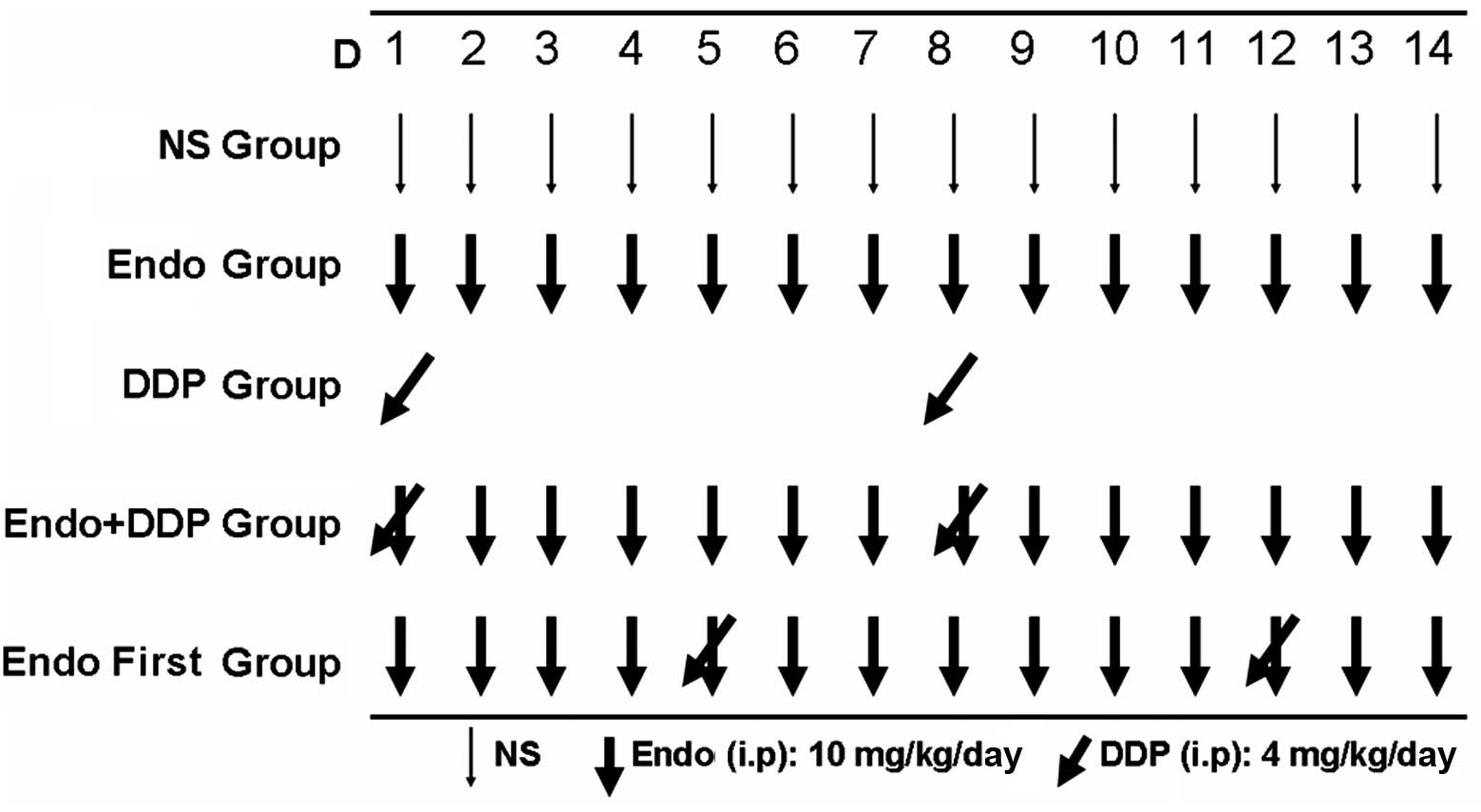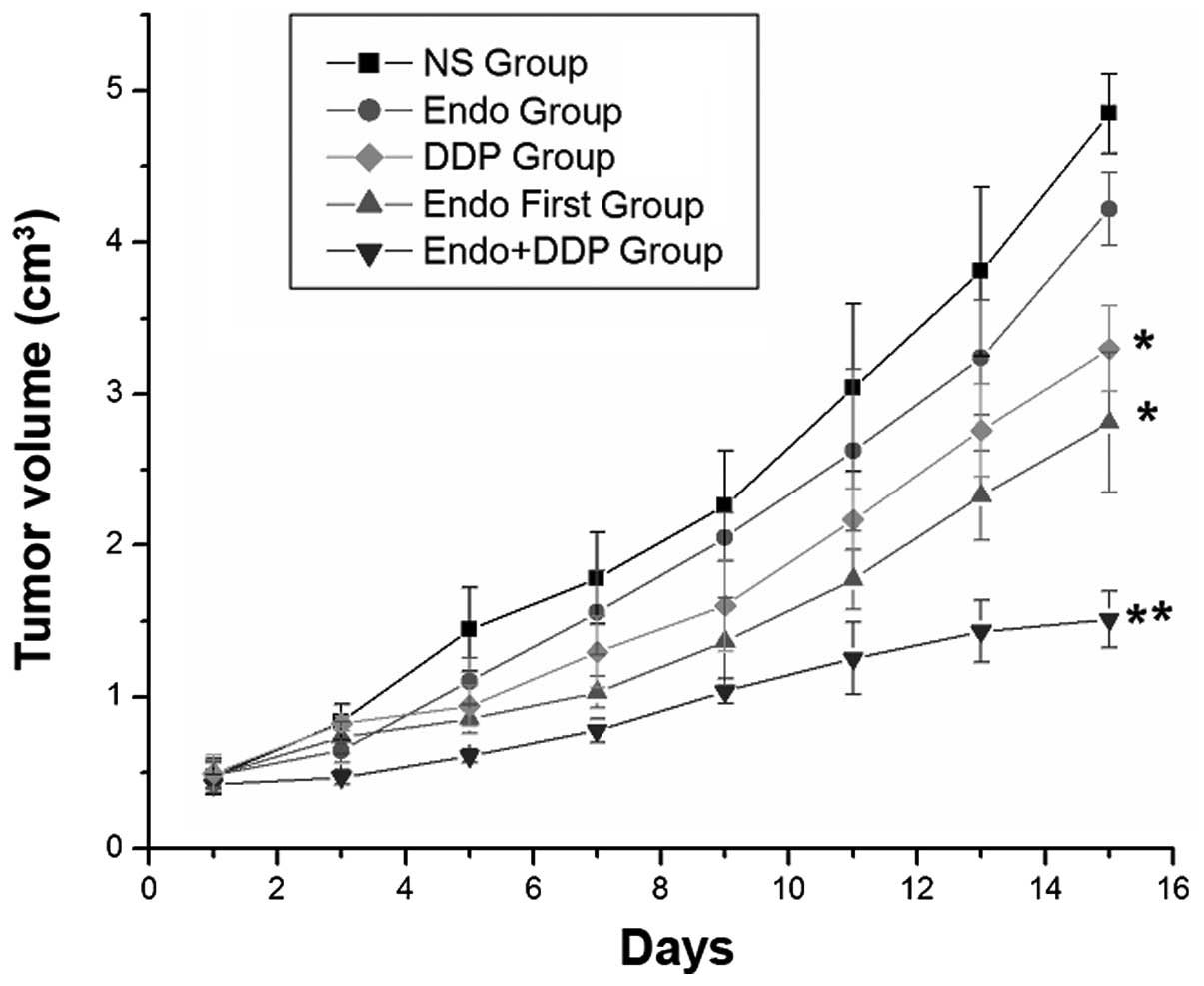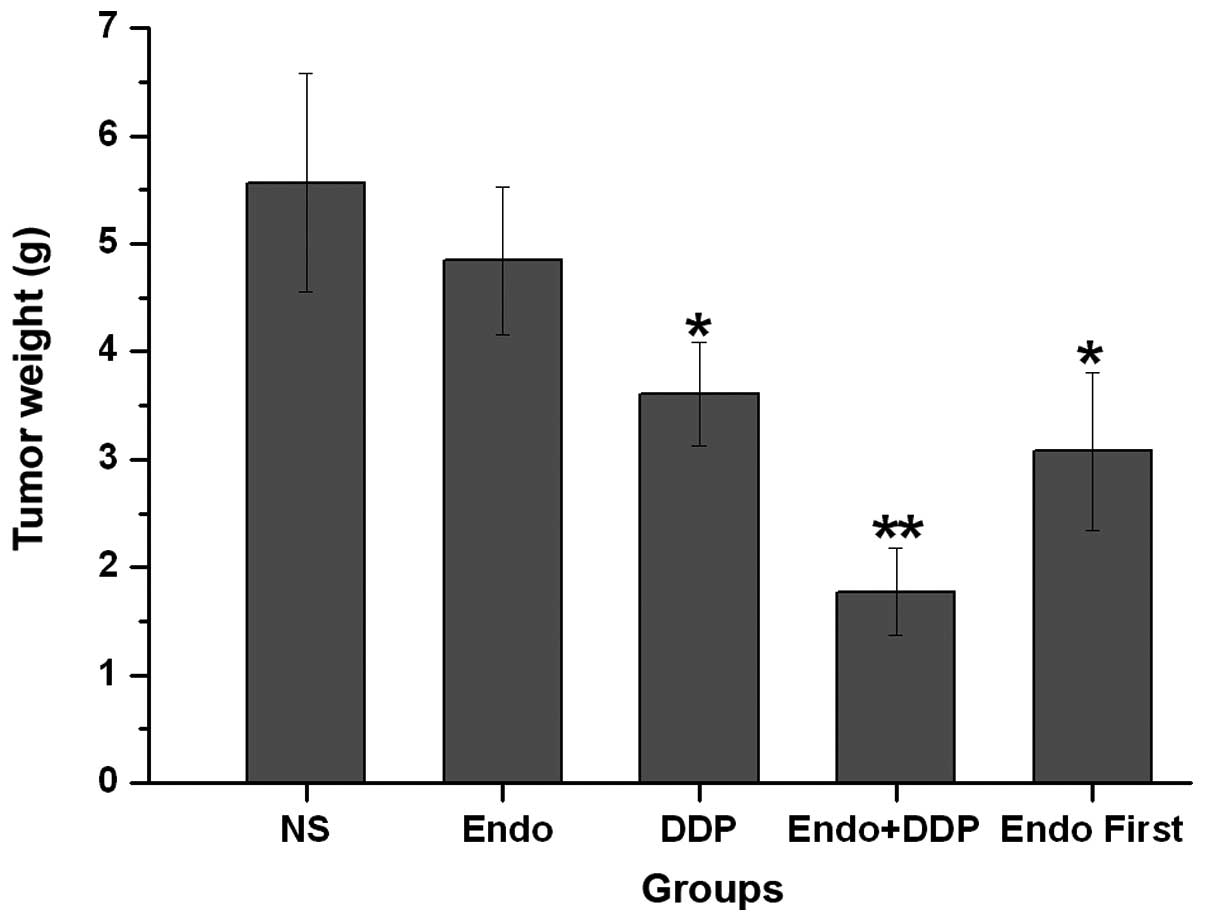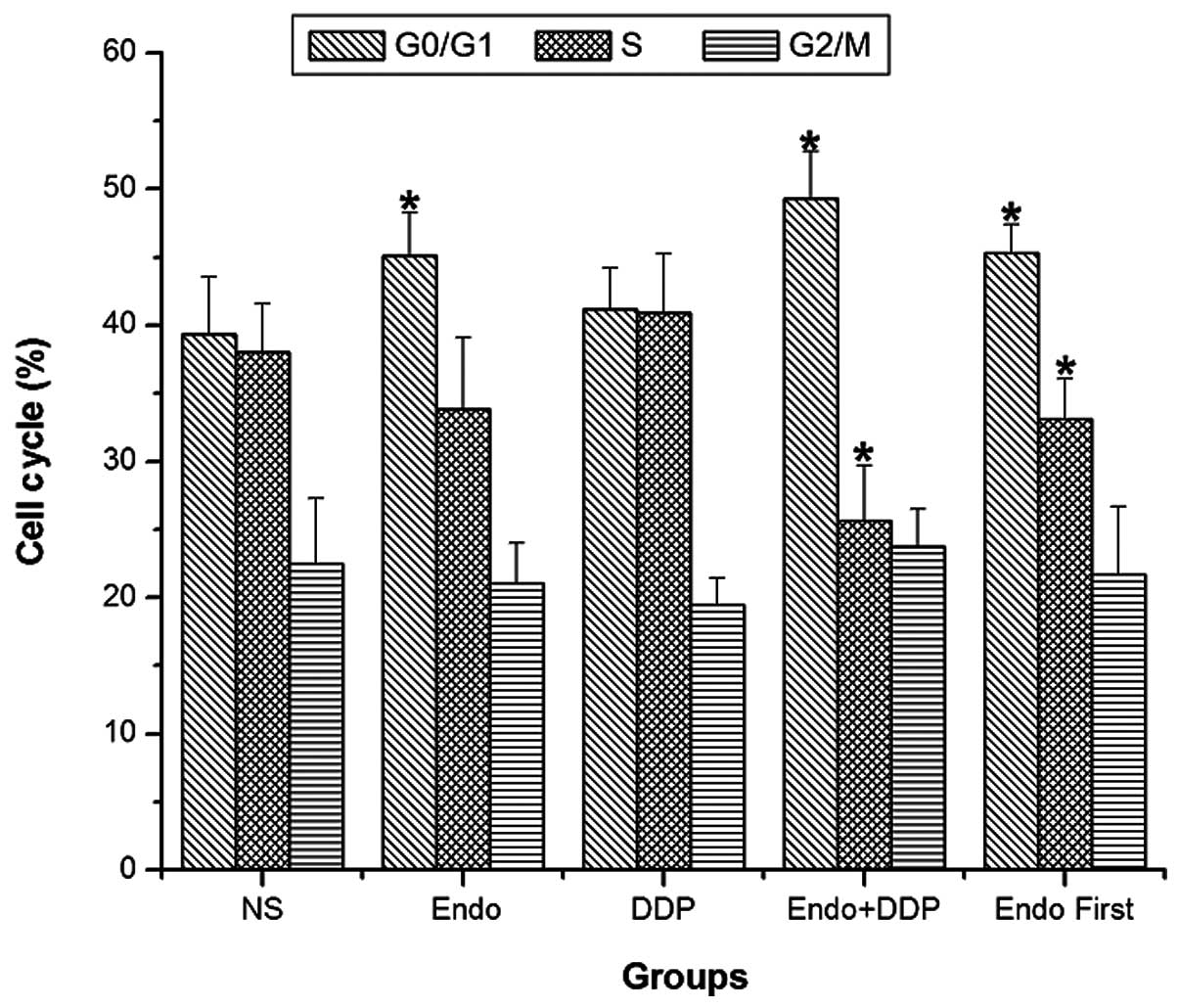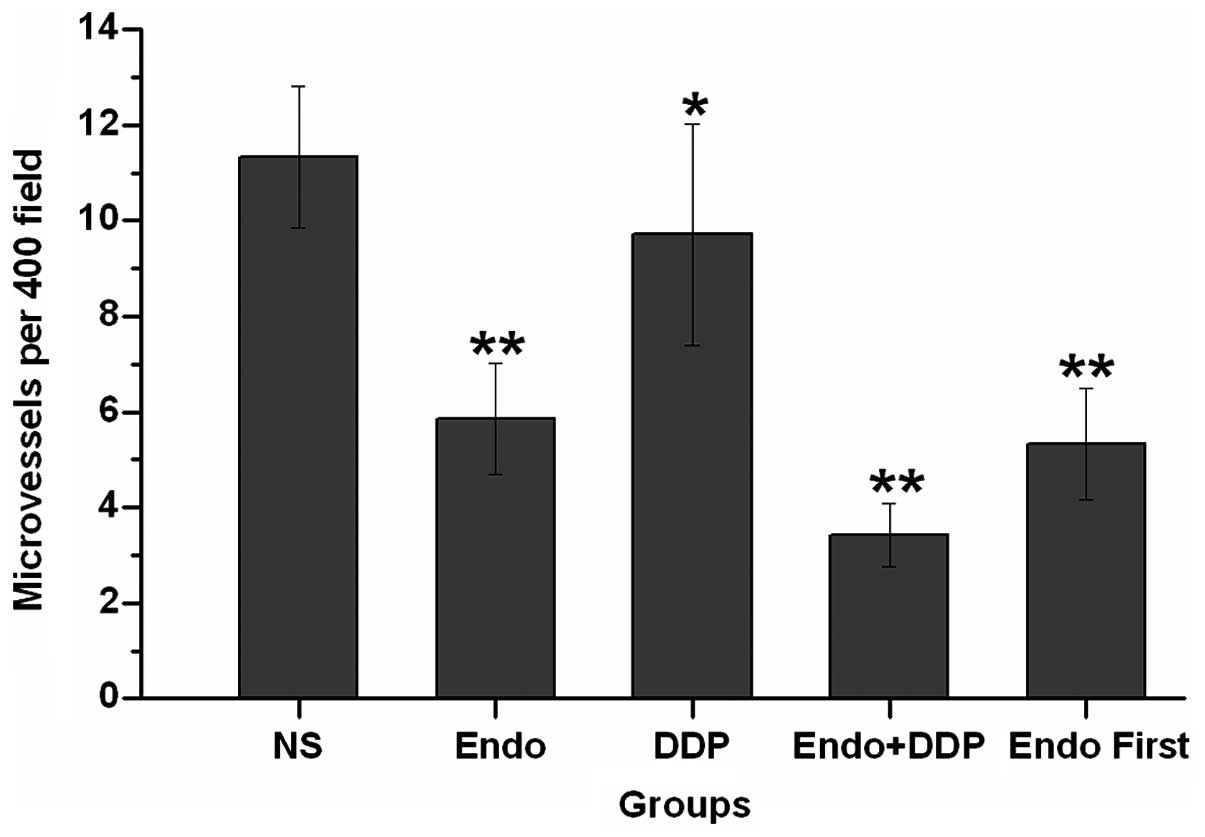|
1
|
Laskin JJ and Sandler AB: First-line
treatment for advanced non-small-cell lung cancer. Oncology
(Williston Park). 19:1671–1676; discussion 1678–1680. 2005.
|
|
2
|
Le Chevalier T, Scagliotti G, Natale R, et
al: Efficacy of gemcitabine plus platinum chemotherapy compared
with other platinum containing regimens in advanced non-small-cell
lung cancer: a meta-analysis of survival outcomes. Lung Cancer.
47:69–80. 2005. View Article : Google Scholar
|
|
3
|
Folkman J: Tumor angiogenesis: therapeutic
implications. N Engl J Med. 285:1182–1186. 1971. View Article : Google Scholar : PubMed/NCBI
|
|
4
|
Browder T, Butterfield CE, Kräling BM, et
al: Antiangiogenic scheduling of chemotherapy improves efficacy
against experimental drug-resistant cancer. Cancer Res.
60:1878–1886. 2000.PubMed/NCBI
|
|
5
|
Bello L, Carrabba G, Giussani C, et al:
Low-dose chemotherapy combined with an antiangiogenic drug reduces
human glioma growth in vivo. Cancer Res. 61:7501–7506.
2001.PubMed/NCBI
|
|
6
|
Ramalingam SS, Dahlberg SE, Langer CJ, et
al; Eastern Cooperative Oncology Group. Outcomes for elderly,
advanced-stage non small-cell lung cancer patients treated with
bevacizumab in combination with carboplatin and paclitaxel:
analysis of Eastern Cooperative Oncology Group Trial 4599. J Clin
Oncol. 26:60–65. 2008. View Article : Google Scholar : PubMed/NCBI
|
|
7
|
Murata R, Nishimura Y and Hiraoka M: An
antiangiogenic agent (TNP-470) inhibited reoxygenation during
fractionated radiotherapy of murine mammary carcinoma. Int J Radiat
Oncol Biol Phys. 37:1107–1113. 1997. View Article : Google Scholar : PubMed/NCBI
|
|
8
|
Ma J, Pulfer S, Li S, Chu J, Reed K and
Gallo JM: Pharmacodynamic-mediated reduction of temozolomide tumor
concentrations by the angiogenesis inhibitor TNP-470. Cancer Res.
61:5491–5498. 2001.PubMed/NCBI
|
|
9
|
Lin MI and Sessa WC: Antiangiogenic
therapy: creating a unique ‘window’ of opportunity. Cancer Cell.
6:529–531. 2004.PubMed/NCBI
|
|
10
|
Jain RK: Normalization of tumor
vasculature: an emerging concept in antiangiogenic therapy.
Science. 307:58–62. 2005. View Article : Google Scholar : PubMed/NCBI
|
|
11
|
Weichselbaum RR: How does antiangiogenic
therapy affect brain tumor response to radiation. Nat Clin Pract
Oncol. 2:232–233. 2005. View Article : Google Scholar : PubMed/NCBI
|
|
12
|
Zhou ZT, Zhou FX, Wei Q, Zou LY, Qin BF
and Peng XS: Phase II study of cisplatin/etoposide and endostar for
extensive-stage small-cell lung cancer. Cancer Chemother Pharmacol.
68:1027–1032. 2011. View Article : Google Scholar : PubMed/NCBI
|
|
13
|
Ma X, Yao Y, Yuan D, Liu H, Wang S, Zhou C
and Song Y: Recombinant human endostatin endostar suppresses
angiogenesis and lymphangiogenesis of malignant pleural effusion in
mice. PLoS One. 7:e534492012. View Article : Google Scholar
|
|
14
|
Lignet F, Benzekry S, Wilson S, et al:
Theoretical investigation of the efficacy of antiangiogenic drugs
combined to chemotherapy in xenografted mice. J Theor Biol.
320:86–99. 2013. View Article : Google Scholar
|
|
15
|
Mabuchi S, Terai Y, Morishige K, et al:
Maintenance treatment with bevacizumab prolongs survival in an in
vivo ovarian cancer model. Clin Cancer Res. 14:7781–7789. 2008.
View Article : Google Scholar : PubMed/NCBI
|
|
16
|
Yuan J, Wu CW, Liu ZJ, Wei XY and Li K:
Observation of the antitumor effect of endostar combined with
docetaxel under different administration sequences. Zhonghua Zhong
Liu Za Zhi. 32:580–585. 2010.(In Chinese). PubMed/NCBI
|
|
17
|
Peng XC, Qiu M, Wei M, et al: Different
combination schedules of gemcitabine with endostar affect antitumor
efficacy. Cancer Chemother Pharmacol. 69:239–246. 2012. View Article : Google Scholar
|
|
18
|
Ling Y, Yang Y, Lu N, et al: Endostar, a
novel recombinant human endostatin, exerts antiangiogenic effect
via blocking VEGF-induced tyrosine phosphorylation of KDR/Flk-1 of
endothelial cells. Biochem Biophys Res Commun. 361:79–84. 2007.
View Article : Google Scholar : PubMed/NCBI
|
|
19
|
Wang J, Sun Y, Liu Y, et al: Results of
randomized, multicenter, double-blind phase III trial of
rh-endostatin (YH-16) in treatment of advanced non-small cell lung
cancer patients. Zhongguo Fei Ai Za Zhi. 8:283–290. 2005.(In
Chinese). PubMed/NCBI
|
|
20
|
Weidner N, Semple JP, Welch WR and Folkman
J: Tumor angiogenesis and metastasis - correlation in invasive
breast carcinoma. New Engl J Med. 324:1–8. 1991. View Article : Google Scholar
|
|
21
|
Winkler F, Kozin SV, Tong RT, et al:
Kinetics of vascular normalization by VEGFR2 blockade governs brain
tumor response to radiation: role of oxygenation, angiopoietin-1,
and matrix metalloproteinases. Cancer Cell. 6:553–563.
2004.PubMed/NCBI
|
|
22
|
Dings RP, Loren M, Heun H, McNiel E,
Griffioen AW, Mayo KH and Griffin RJ: Scheduling of radiation with
angiogenesis inhibitors anginex and Avastin improves therapeutic
outcome via vessel normalization. Clin Cancer Res. 13:3395–3402.
2007. View Article : Google Scholar : PubMed/NCBI
|
|
23
|
Ohta M, Kawabata T, Yamamoto M, et al:
TSU68, an antiangiogenic receptor tyrosine kinase inhibitor,
induces tumor vascular normalization in a human cancer xenograft
nude mouse model. Surg Today. 39:1046–1053. 2009. View Article : Google Scholar : PubMed/NCBI
|
|
24
|
Peng F, Xu Z, Wang J, et al: Recombinant
human endostatin normalizes tumor vasculature and enhances
radiation response in xenografted human nasopharyngeal carcinoma
models. PLoS One. 7:e346462012. View Article : Google Scholar : PubMed/NCBI
|
|
25
|
Xin G, Du J, Zhu L, Yu YH, Li Y and Liu
PS: Differential anti-tumor effects for various regimens of
endostar plus cisplatin in ovarian cancer. Zhonghua Yi Xue Za Zhi.
91:3367–3370. 2011.(In Chinese).
|
|
26
|
Tong RT, Boucher Y, Kozin SV, Winkler F,
Hicklin DJ and Jain RK: Vascular normalization by vascular
endothelial growth factor receptor 2 blockade induces a pressure
gradient across the vasculature and improves drug penetration in
tumors. Cancer Res. 64:3731–3736. 2004. View Article : Google Scholar : PubMed/NCBI
|
|
27
|
Guşet G, Costi S, Lazăr E, Dema A,
Cornianu M, Vernic C and Păiuşan L: Expression of vascular
endothelial growth factor (VEGF) and assessment of microvascular
density with CD34 as prognostic markers for endometrial carcinoma.
Rom J Morphol Embryol. 51:677–682. 2010.
|
|
28
|
Bocci G, Nicoluaou KC and Kerbel RS:
Prutracted low-dose effects on human endothelial cell proliferation
and survival in vitro reveal a selective antiangiogenic window for
various chemotherapeutic drugs. Cancer Res. 62:6938–6943.
2002.PubMed/NCBI
|
|
29
|
Wu SM, Zhao YA, Yang L, Wang L, et al:
Effects of recombinant human angiostatin on vascular endothelial
cell. Chin J Aesthetic Med. 17:685–688. 2008.
|
|
30
|
You ZY, Zhao Y, Liu F, Zhang YD and Wang
JJ: The radiosensitization effects of Endostar on human lung
squamous cancer cells H-520. Cancer Cell Int. 10:172010. View Article : Google Scholar : PubMed/NCBI
|
|
31
|
Xu WJ, Huang C, Wang J, et al: Comparison
of the effects of recombinant human endostatin and docetaxel on
human umbilical vein endothelial cells in different growth states.
Chin Med J (Engl). 124:2883–2889. 2011.
|



